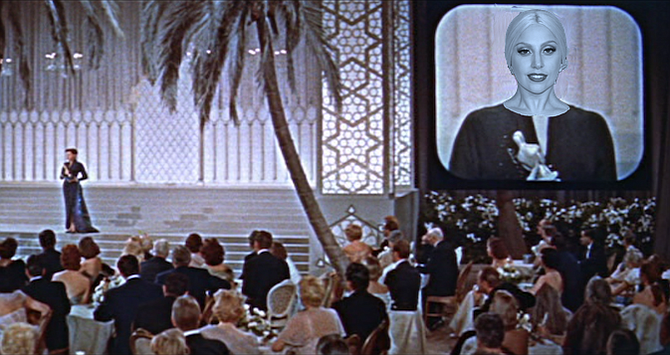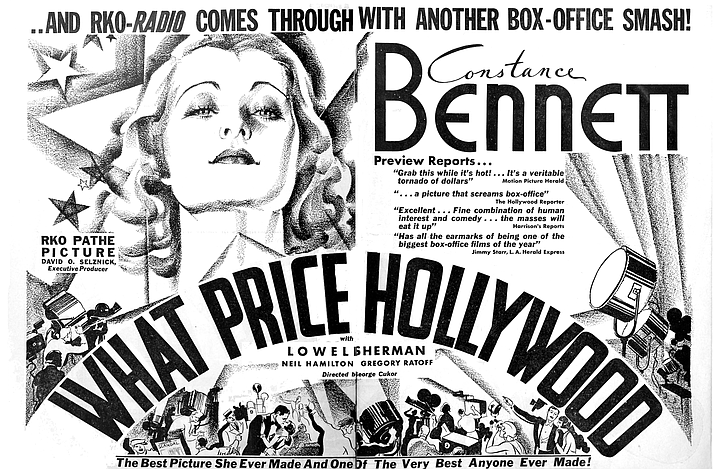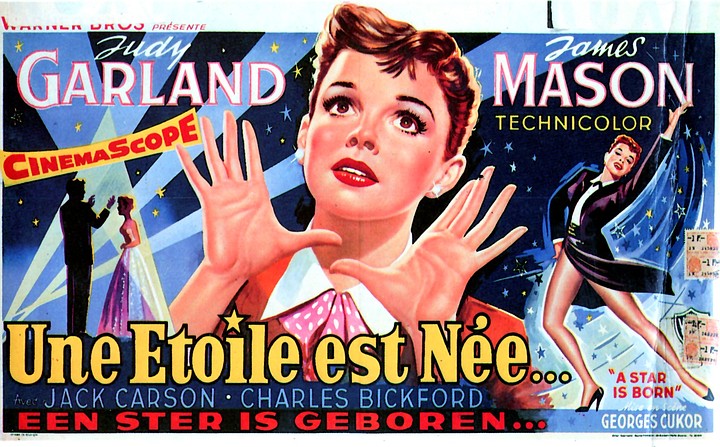 Facebook
Facebook
 X
X
 Instagram
Instagram
 TikTok
TikTok
 Youtube
Youtube

She’s been praised for cutting-edge performances powered by an “assertion of total originality.” If that’s the case, why is Lady Gaga singing a familiar tune by entertaining a remake of the ancestral A Star Is Born for her big screen debut?
Get the lady a copy of Glitter, stat!
According to The Hollywood Reporter, “The singer is in talks to star opposite Bradley Cooper in...the remake that Cooper also will direct.”

This would make the fifth Hollywood treatment of a tale that began in 1932 under the working title The Truth About Hollywood. For those who don’t know, the story juxtaposes two meteoric careers — a skyrocketing actress and her director/husband in mid-downward spiral — set on a collision course. Writers Adela Rogers St. John and Louis Stevens based their story on the relationship between silent film star Colleen Moore and her alcoholic husband, producer John McCormick, with an added dash of Tom Forman, the 33-year-old actor who, not long after being diagnosed with nervous breakdown, put a bullet through his chest.
Renamed What Price Hollywood?, the film starred Constance Bennett in the role of plucky ingénue and Lowell Sherman, a superb director in his own right, as her hard-drinking hubby. It would be the seventh feature helmed by George Cukor and the first of two versions produced by David O. Selznick.

The film was such a hit that four years later Selznick offered Cukor the director’s chair on A Star Is Born. The up-and-coming director, not wanting to be accused of plagiarism, politely declined. Cukor wasn’t the only one to spot the cribbing. R.K.O., the studio behind What Price Hollywood?, toyed with taking Selznick International Pictures to court but eventually backed down.
Directed by William Wellman and starring Janet Gaynor and Frederic March as the doomed couple, it’s easily the most pedestrian of the first three go-rounds. Selznick spared no expense. Made at the tail end of the Great Depression, the studio funneled over a million dollars into the production. It wasn’t the first feature shot in color — Becky Sharpe, Trail of the Lonesome Pine, and Snow White came first — so Selznick decided to sell it as “the first modern dress story in Technicolor.” The film took home two Oscars: Best Original Story statues for William Wellman and Robert Carson as well as a special award to cinematographer W. Howard Greene.

George Cukor was a man fated to work in just about every conceivable genre. A song-and-dance movie had yet to be checked off the list when in 1952 Sid Luft presented him with the prospect of a musical remake of A Star Is Born for his wife Judy Garland. Cukor jumped at the opportunity. The musical would also be Cukor’s first color production as well as the first of several films shot in CinemaScope.
One would think that a director who spent so many years at M.G.M. would have been assigned at least one musical. Cukor was saving it up for the brothers Warner. It’s my go-to picture when asked to name a remake that outclasses the original. The 1954 version — and its subsequent 1983 restoration — joins Howard Hawks’ Gentlemen Prefer Blondes as one of the few non-Metro musical of the 1950s to challenge the output of the studio’s almighty Freed Unit.
Kris Kristofferson has said of his days spent on the 1976 remake, “Filming with Streisand is an experience which may have cured me of the movies.” Frank Pierson signed it, but something tells me Babs called the shots on this vanity production. It’s the longest 139 minutes you’ll ever spend watching a musical. Gaga and Cooper might actually be an improvement.


She’s been praised for cutting-edge performances powered by an “assertion of total originality.” If that’s the case, why is Lady Gaga singing a familiar tune by entertaining a remake of the ancestral A Star Is Born for her big screen debut?
Get the lady a copy of Glitter, stat!
According to The Hollywood Reporter, “The singer is in talks to star opposite Bradley Cooper in...the remake that Cooper also will direct.”

This would make the fifth Hollywood treatment of a tale that began in 1932 under the working title The Truth About Hollywood. For those who don’t know, the story juxtaposes two meteoric careers — a skyrocketing actress and her director/husband in mid-downward spiral — set on a collision course. Writers Adela Rogers St. John and Louis Stevens based their story on the relationship between silent film star Colleen Moore and her alcoholic husband, producer John McCormick, with an added dash of Tom Forman, the 33-year-old actor who, not long after being diagnosed with nervous breakdown, put a bullet through his chest.
Renamed What Price Hollywood?, the film starred Constance Bennett in the role of plucky ingénue and Lowell Sherman, a superb director in his own right, as her hard-drinking hubby. It would be the seventh feature helmed by George Cukor and the first of two versions produced by David O. Selznick.

The film was such a hit that four years later Selznick offered Cukor the director’s chair on A Star Is Born. The up-and-coming director, not wanting to be accused of plagiarism, politely declined. Cukor wasn’t the only one to spot the cribbing. R.K.O., the studio behind What Price Hollywood?, toyed with taking Selznick International Pictures to court but eventually backed down.
Directed by William Wellman and starring Janet Gaynor and Frederic March as the doomed couple, it’s easily the most pedestrian of the first three go-rounds. Selznick spared no expense. Made at the tail end of the Great Depression, the studio funneled over a million dollars into the production. It wasn’t the first feature shot in color — Becky Sharpe, Trail of the Lonesome Pine, and Snow White came first — so Selznick decided to sell it as “the first modern dress story in Technicolor.” The film took home two Oscars: Best Original Story statues for William Wellman and Robert Carson as well as a special award to cinematographer W. Howard Greene.

George Cukor was a man fated to work in just about every conceivable genre. A song-and-dance movie had yet to be checked off the list when in 1952 Sid Luft presented him with the prospect of a musical remake of A Star Is Born for his wife Judy Garland. Cukor jumped at the opportunity. The musical would also be Cukor’s first color production as well as the first of several films shot in CinemaScope.
One would think that a director who spent so many years at M.G.M. would have been assigned at least one musical. Cukor was saving it up for the brothers Warner. It’s my go-to picture when asked to name a remake that outclasses the original. The 1954 version — and its subsequent 1983 restoration — joins Howard Hawks’ Gentlemen Prefer Blondes as one of the few non-Metro musical of the 1950s to challenge the output of the studio’s almighty Freed Unit.
Kris Kristofferson has said of his days spent on the 1976 remake, “Filming with Streisand is an experience which may have cured me of the movies.” Frank Pierson signed it, but something tells me Babs called the shots on this vanity production. It’s the longest 139 minutes you’ll ever spend watching a musical. Gaga and Cooper might actually be an improvement.
Comments